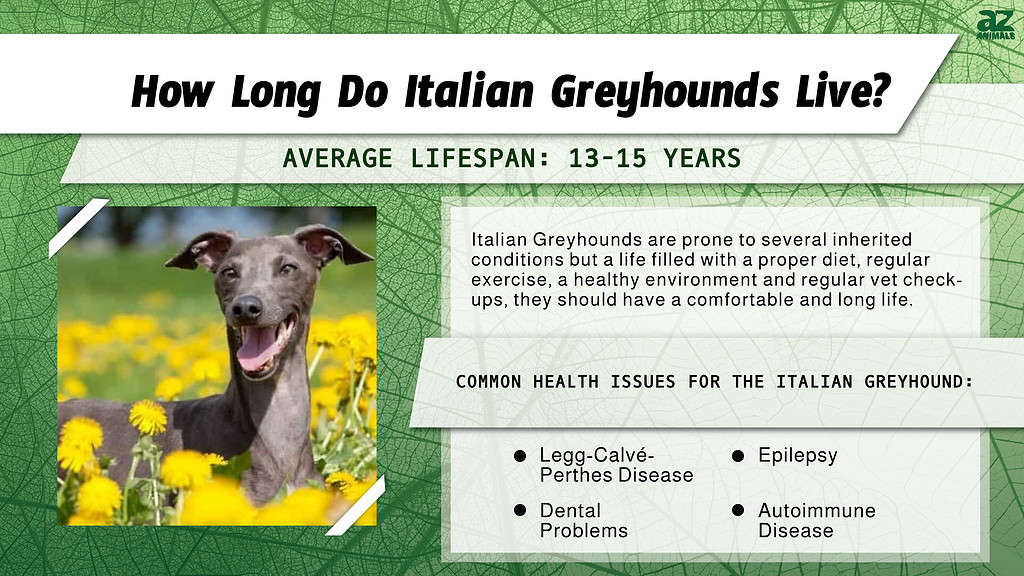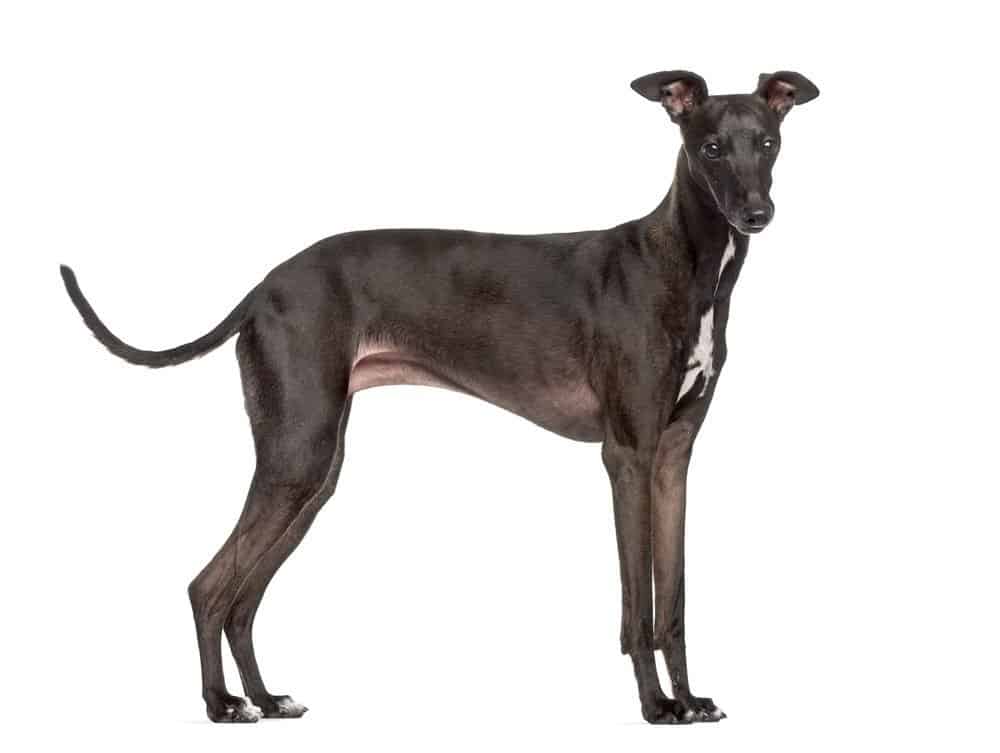If you are considering adding an Italian greyhound to your family, one of the questions you’ll ask is about Italian greyhounds’ lifespan: How long do Italian greyhounds live? It’s a good question and one we’ll answer in this article, along with more information on the breed and how its particular characteristics affect its lifespan.

How Long Do Italian Greyhounds Live?
Italian greyhounds live for 13-15 years. Generally a long-lived breed, it’s not uncommon that they reach 18 years old with the right care and veterinary attention.
Their long-lived nature means Italian greyhounds are suitable companion dogs for a family that wants a happy new member to grow alongside.
What Kind of Dog Is an Italian Greyhound?
Many potential Italian greyhound owners wonder what type of dog an Italian greyhound is, so let’s take a look at their characteristics.
Italian greyhounds, or IGs/Iggys as they’re called, are members of the toy breed group. They are small dogs, often considered lapdogs, that make wonderful companions. This happy-natured dog loves attention and affection. If you don’t pay attention, they will make sure you do!
Although they look fit and muscular, Italian greyhounds don’t require huge amounts of exercise. A daily walk and a yard to sniff around is usually enough to keep them occupied. In fact, Iggys are often labeled as “quite lazy” by their owners.
Intelligence is high in this breed. Iggys are clever dogs but headstrong and keen to do their own thing, so early training is essential. Naturally quite shy, this sleek dog breed requires socialization from an early age to encourage their confidence and damp down their natural timidity.
What Do Italian Greyhounds Look Like?
Italian greyhounds reach 13-15 inches tall and weigh just 7-14 pounds. Their short, shiny coats, long legs, and pointed snouts point them out as a sighthound.
Iggys are the smallest sighthounds and share many characteristics with larger greyhounds and whippets. Italian greyhounds look very like whippets, and they’re often confused. However, 22-inch tall whippets are bigger and part of the hound group, whereas short IGs are in the toy group. Italian greyhounds also have a distinctive high-stepping gait that sets them apart from greyhounds and whippets. Greyhounds, whippets, and Italian greyhounds all have similar lifespans.
Because Italian greyhounds are sighthounds, they rely on good vision, agility, and speed to catch prey. Their sleek, slender, and streamlined frames reach top speeds of 25 miles per hour.
In terms of coat color, we have white, cream, bronze, gold, slate grey, and bi-colors, which are white with patches of bronze, gray, or gold.

Their sleek, slender, and streamlined frames allow Italian greyhounds to reach top speeds of 25 miles per hour.
©Eric Isselee/Shutterstock.com
Are Italian Greyhounds Good Family Dogs?
Italian greyhounds make loving family companions once their initial reticent nature warms up, and their long life span means they often become an integral part of the family, growing up with children and providing a constant friend. However, their young, fragile bones and delicate, slender construction mean they’re not for rough-and-tumble children.
Centuries of breeding have given this happy hound a strong prey drive so that they may chase small fluffy animals such as squirrels, cats, and rabbits, so that’s something to be aware of if you already have other household animals.
How Old Was the Oldest Ever Italian Greyhound?
No record exists to indicate the age of the oldest ever Italian greyhound, but the breed is an old one.
Italian greyhounds may have existed for over 2,000 years in Turkey or Greece. A similar dog appears in Egyptian hieroglyphics. During the Renaissance, IGs were one of the most popular dog breeds, appearing as a lapdog in 16th-century Italian aristocratic paintings. It’s said Mary, Queen of Scots, Catherine the Great, and Queen Victoria all loved their pet Italian greyhounds.
The breed arrived in England in the 1800s, garring the name “Italian Greyhound.”
Italian Greyhound: Behavior
Italian greyhounds’ friendly personalities can feel a little needy and overwhelming. Daily exercise and plenty of play time can help keep them off your lap all day. Sensitive souls become withdrawn if shouted at or ignored. Positive reinforcement is essential during training sessions and playtime.
Factors That Impact an Italian Greyhound’s Lifespan
Like most pure dog breeds, Italian greyhounds are prone to specific health issues that may affect their lifespan. Let’s take a look at the Italian greyhound’s potential health conditions.
Genetics
Always buy an Italian greyhound from a reputable breeder to ensure they have strong genetics. Interbreeding creates a whole host of issues. Many breeders carry out DNA checks on parent dogs to prevent genetic problems. Some Italian greyhound-specific DNA tests include autoimmune problems, Legg-Calve-Perthes disease, and dental problems.
It’s a good idea for adopters to have their Italian greyhound evaluated for issues as soon as possible.
Autoimmune Disease
Italian greyhounds are susceptible to autoimmune issues. This is when their immune system mistakes an organ or tissue for an invader and attacks it. Diagnostic tests identify autoimmune cases, and veterinarians can provide support, such as autoimmune suppressant therapy.
Dental Problems
Periodontium tissues surround and support teeth. Italian greyhounds are susceptible to infection and inflammation in these tissues, which can lead to dental problems such as tooth loss in the long run. Vets recommend daily brushing to prevent periodontal disease.
Epilepsy
An inherited condition, epilepsy is a brain disorder that can lead to seizures. If they have epilepsy, Italian greyhounds usually develop symptoms between six months and three years.
Epilepsy is treated with drugs via a veterinarian. If it’s promptly and regularly treated, epilepsy should not affect their lifespan.
Luxating Patellas
This is when kneecaps temporarily slip out of place. An Italian greyhound will carry out an odd little jump to push them back in.
If they remain out of place, weight bearing is difficult. It’s often genetic, but accidents also cause luxating patella. Because Italian greyhounds have long, delicate legs, they are prone to leg and kneecap issues.
Legg-Calvé-Perthes Disease
Legg-Calve-Perthes disease is a bit of a mouthful, but it’s a condition that Italian greyhounds are prone to. This disease may be genetic, but its cause is unknown.
Simply put, it is when the ball part of the hip’s ball and socket joint degrades over time. It leads to lameness, limping, and favoring the unaffected leg.
Progressive Retinal Atrophy
This is when eyesight gradually deteriorates. Italian greyhounds are prone to this eye disease that eventually causes blindness. It’s inherited and can’t be prevented.
Often, night blindness occurs first, followed by loss of sight in daylight. Bright rooms can help an Italian greyhound make its way around safely.
How to Extend an Italian Greyhound’s Lifespan
Italian greyhounds live on average from 13-15 years, and there are a few ways to increase your pet’s odds of making it into comfortable old age.
Spraying and neutering: Sprayed and neutered dogs have fewer health issues overall.
Exercise: Regular exercise keeps weight down and strengthens a dog’s muscles. Frequent walks, playtime, and swimming all count, but don’t overwork a young dog with growing bones, as it leads to joint problems. Italian greyhounds are not delicate coddle dogs, but some care is needed to protect their slender legs and sleek build from excess weight or rough and tumble damage.
Diet: Nutritionally balanced food is essential for all dogs. The right healthy diet dramatically improves their well-being and extends their lifespan. IGs benefit from joint supplements like glucosamine. Consult a veterinarian for supplement advice.
Environment: Italian greyhounds don’t suit permanent outdoor life because their coats are too short to provide enough warmth or sun protection.
Lifespan: How Long Do Italian Greyhounds Live For?
Italian greyhounds, on average, live 13-15 years, but many reach an 18-year lifespan.
They are beautiful pets that naturally have a good work/life balance. They love running and snuggling equally. Their friendly, loving nature demands attention, and they make great companion pets for families with older, less “rough-and-tumble” kids.
With the proper nutrition, health care, exercise, and love, an Italian greyhound is long-lived and full of affection. It’s no wonder these joyful dogs have remained popular for over 2,000 years.
The photo featured at the top of this post is © Lenkadan/Shutterstock.com
Ready to discover the top 10 cutest dog breeds in the entire world?
How about the fastest dogs, the largest dogs and those that are -- quite frankly -- just the kindest dogs on the planet? Each day, AZ Animals sends out lists just like this to our thousands of email subscribers. And the best part? It's FREE. Join today by entering your email below.
Thank you for reading! Have some feedback for us? Contact the AZ Animals editorial team.






